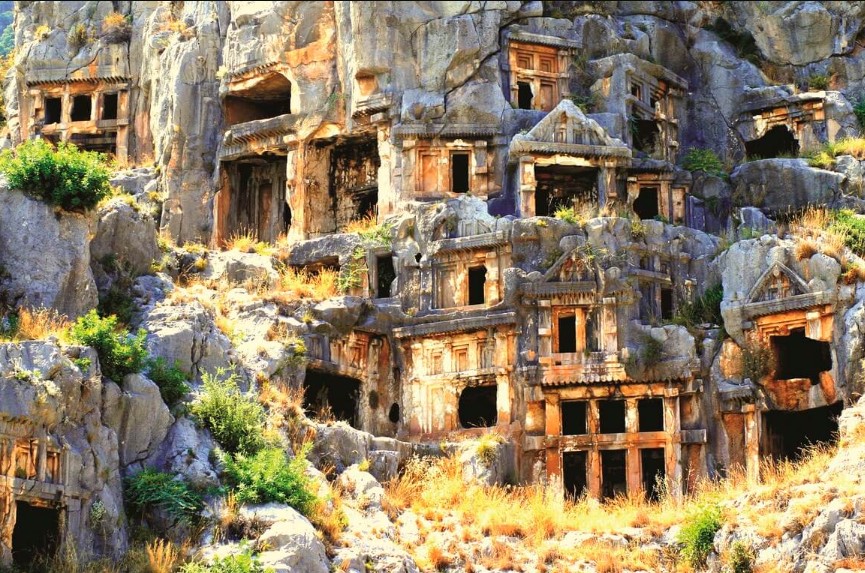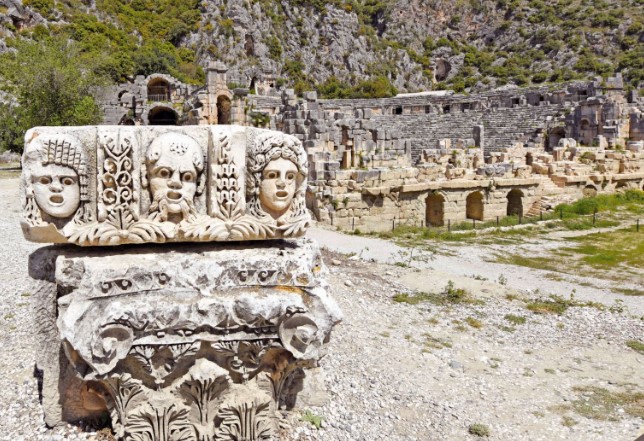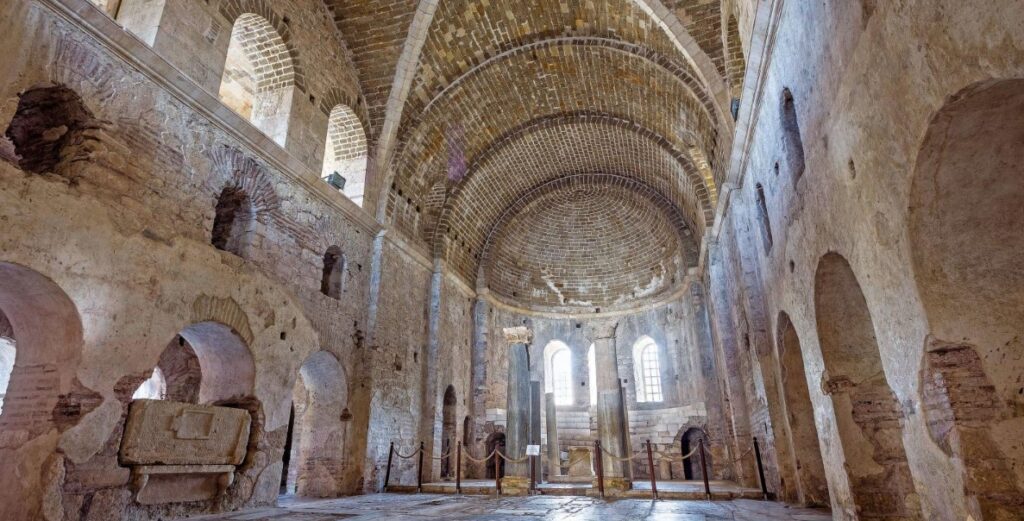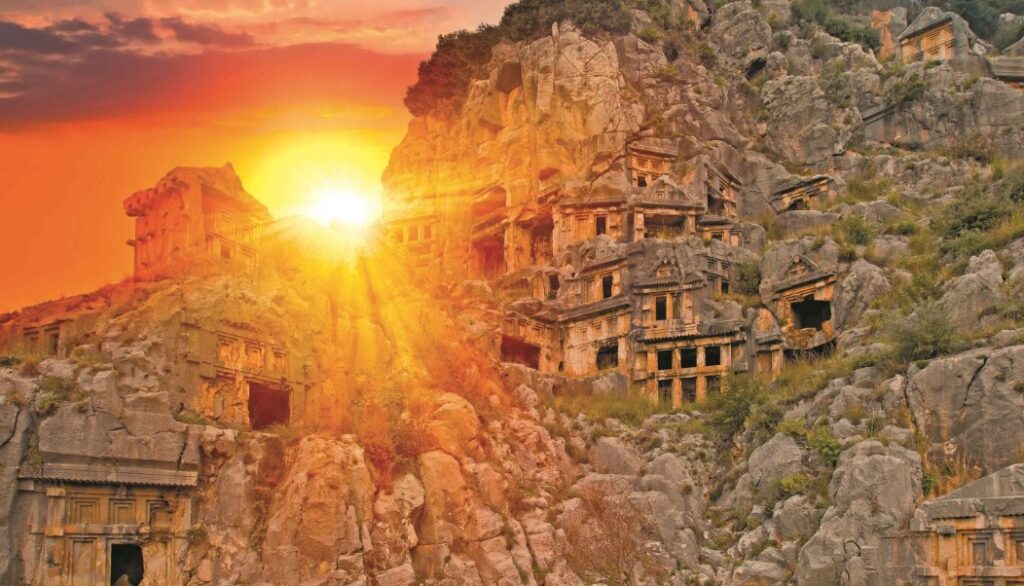Myra is a captivating ancient city located in Antalya, Turkey. Known for its remarkable ruins and deep historical roots, Myra draws visitors who are fascinated by archaeology and ancient cultures. This city was a significant player in the region of Lycia, and today, it offers a rich tapestry of history to explore.

Myra was a leading city of the Lycian Union and superseded Xanthos in the early Byzantine period to become the capital of the Lycia Union. The ruins of Myra are situated about 2 km north of today’s Demre, on the Finike – Kas road. Today this large plain is almost covered with fields stuffed full of tomatoes. In ancient times this area was also probably farmed extensively for trade purposes with the interior parts of the Lycian Union.
Myra is well known for its theater (the largest one in Lycia) and the plethora of rock-cut tombs carved in the cliffs above the ancient theatre of Myra. The St. Nicholas Church is a must see and is a short distance from the site of Myra on the outskirts of Demre and is really worth the trip. Inside the church is the sarcophagus of St. Nicholas although his remains were taken to Italy in the 19th century. The earliest church of St. Nicholas was built in the 6th century AD, probably over St. Nicholas’s tomb. Later the church was rebuilt in the 9th century (probably rebuilt after Arab attacks).
It was further rebuilt in 1042 under the patronage of Constantine of the Byzantine Empire, and a monastery was added at that time. Czar Alexander II of Prussia bought the building in 1863 and began to have it restored, but the renovation was never completed. Excavations and restorations were done during the 1960s and continue even today from the early 1990s. St.Nicholas Church, Myra, TurkeyThe church floor is made of beautiful types of luxury marble mosaic floor tilings, and there are some remains of wall paintings. A marble sarcophagus was reused to bury the bones of St. Nicholas himself but actually was stolen earlier and taken to Bari, Italy.
St.Nicholas was a popular bishop at Myra in the 4th century AD, born in Patara between 260 and 280 AD. St. Nicholas was famous for his miracles and was known for his kindness. His parents died of the plague and he was left as a wealthy young man. St. Nicholas was known for his charitable nature and humility. Several legends about him have been based on his kind and giving nature and have led to the development of Santa Claus. Today, Noel of Christianity is rooted in St. Nicholas of Myra.
Table of Contents
Location of Myra Turkey
Myra can be found near the town of Demre in Antalya Province, nestled along Turkey’s beautiful Mediterranean coast. It’s approximately 140 kilometers southwest of Antalya’s bustling city center, surrounded by picturesque landscapes and steeped in historical significance.
How to Get to Myra
Reaching Myra is fairly easy, with several transportation options available for travelers. Visitors can choose to drive, take a bus, or join one of the many guided tours departing from Antalya or nearby towns.
– By Car: Driving from Antalya to Myra takes about 2.5 hours, with well-kept roads and clear signage making the journey smooth.
– By Bus: Regular buses travel from Antalya’s city center to Demre. From Demre, local transportation can bring you to Myra.
– Guided Tours: Numerous tour operators offer day trips to Myra, often including nearby attractions like Kekova and the Church of St. Nicholas.
Highlights of Myra
Myra is home to incredible structures that highlight its historical and cultural importance. Key attractions include:
– Rock-Cut Tombs: These ancient tombs are carved into the cliffs, featuring intricate designs that speak to the artistry of the Lycian people.

– Roman Theater: One of the best-preserved theaters of its kind, it could seat up to 10,000 spectators for various performances.
– St. Nicholas Church: Dedicated to St. Nicholas, the bishop of Myra, this church is a significant pilgrimage site, adorned with beautiful frescoes.

– Lycian Acropolis: Offering stunning views of the surrounding area, the acropolis was a fortified center used for defense and administration.

Why Visit Myra?
Visiting Myra provides a unique opportunity to delve into ancient Lycian culture and the Roman influence that shaped it. The city’s ruins are remarkably well-preserved, offering a tangible connection to the past.
– Historical Significance: As a major city in ancient Lycia, Myra played a crucial role in trade and politics.
– Architectural Marvels: The city’s architecture, from its rock-cut tombs to its Roman theater, showcases impressive engineering skills.
– Cultural Insights: Exploring Myra reveals insights into ancient social and religious life, with its association with St. Nicholas adding cultural depth.
Myra Legends and History
Myra boasts a rich history, woven with legends and historical narratives. It was one of the major cities in Lycia, flourishing during the Hellenistic period and later becoming a key center under Roman rule.
St. Nicholas, who inspired the legend of Santa Claus, served as the bishop of Myra in the 4th century. Known for his generosity and kindness, many stories about St. Nicholas originate from his time in Myra.
The city’s decline began in the Byzantine period, attributed to natural disasters and shifts in trade routes, yet its historical significance endures.
Interesting Facts About Myra
– Ancient City: Myra was one of the six prominent cities in the Lycian League, renowned for its wealth and cultural influence.
– Rock-Cut Tombs: Unique to Lycian culture, these tombs are carved directly into the cliffs, often resembling wooden houses.
– St. Nicholas: The link to St. Nicholas makes Myra an important site for pilgrimage, attracting visitors to the church dedicated to him.
– Roman Influence: Myra’s architecture bears the marks of Roman influence, with structures like the theater showcasing Roman engineering prowess.
Myra Architecture and Design
The architecture of Myra stands as a testament to its historical development and cultural influences. The city features distinctive structures and designs.
– Rock-Cut Tombs: These tombs, with their elaborate facades, are a hallmark of Lycian architecture.
– Roman Theater: The well-preserved theater, with its semicircular design, was used for performances and public gatherings.
– St. Nicholas Church: This church, with its basilica layout, features stunning frescoes and has undergone several restorations.
– Lycian Acropolis: The acropolis, a fortified area, housed administrative buildings and offers panoramic views of the region.
Myra Ancient City Nearby Attractions
Several attractions near Myra are worth exploring.
– Kekova: Known for its underwater ruins, this nearby island offers boat tours to view the sunken city.
– St. Nicholas Church: Located in Demre, this church dedicated to St. Nicholas features beautiful frescoes and draws many pilgrims.
– Patara: This ancient city is famous for its long sandy beach and historical ruins, once an important Lycian port city.
– Demre: The town of Demre offers shopping, dining, and cultural experiences, serving as a convenient base for exploring the region.
Best Time to Visit Myra Turkey
The ideal time to visit Myra is during the spring (April to June) and autumn (September to November) when the weather is mild and pleasant, perfect for exploring ruins. Summers can be quite hot, while winters might bring rain.
Dress Code
There is no strict dress code for visiting Myra, but it’s advised to dress comfortably for outdoor exploration.
– Comfortable Shoes: Since the site involves a lot of walking, sturdy footwear is a must.
– Sun Protection: Hats, sunglasses, and sunscreen are essential to guard against the sun.
– Light Clothing: Wear light, breathable clothes, especially during warmer months.
Myra Turkey Opening Hours
Myra is open to visitors year-round. Typically, the site opens at 8:30 AM and closes at 7 PM during the summer, while in winter, it shuts earlier, around 5 PM. It’s wise to check the schedule in advance.
Myra Turkey Entrance Fees
There is an entrance fee to explore Myra, which is reasonable and allows access to the entire site. Discounts might be available for children and students.
## Museum Pass: Valid or Not
The Museum Pass Turkey can be used for entry to Myra, granting unlimited access to numerous museums and archaeological sites across Turkey, making it a cost-effective choice for those visiting multiple locations.
Tips for Visitors
Here are a few tips to enhance your visit to Myra:
1. Arrive Early: Early visits help you avoid crowds, offering a more relaxed experience.
2. Bring Water: Hydration is key, especially on hot days, and on-site facilities are limited.
3. Take Photos: Myra offers excellent photo opportunities with its stunning ruins and scenery.
4. Use a Guidebook: A guidebook or map can enrich your visit by providing additional context about the site.
5. Respect the Site: Avoid climbing on ruins or removing artifacts to preserve the site for future generations.
FAQ
How do I get to Myra from Antalya?
– You can drive, take a bus, or join a guided tour. The trip takes about 2.5 hours by car.
What is the best time to visit Myra?
– Spring and autumn are the best times, with mild weather ideal for exploration.
Is there an entrance fee for Myra?
– Yes, there is an entrance fee to access the site.
Can I use the Museum Pass Turkey at Myra?
– Yes, the Museum Pass is valid for entry to Myra.
Are guided tours available at Myra?
– Yes, guided tours are available and provide valuable insights into the site’s history.
In summary, Myra is an extraordinary ancient city that takes you on a journey through history. With its well-preserved ruins and rich cultural legacy, it stands out as a must-visit destination. Whether you’re drawn to ancient architecture or curious about the city’s storied past, Myra offers something for everyone. Enjoy the allure and history of this fascinating site in Antalya.
Address: Myra Archaeological Site, Demre / Antalya
Telephone: +90 (242)-238-56-88
Internet Address: http://www.antalyamuzesi.gov.tr/tr/myra-orenyeri



